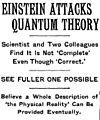EPR paradox facts for kids
The EPR paradox is a famous idea from Albert Einstein and his friends, Boris Podolsky and Nathan Rosen. It was a big challenge to the new science of quantum mechanics in the 1930s. Einstein and his team thought that some ideas about how tiny particles work were incomplete.
Contents
What Is the Uncertainty Principle?
One of the main ideas in quantum mechanics was Werner Heisenberg's Uncertainty Principle. This principle says that for very tiny things, like atoms or smaller particles, you cannot know everything about them at once. For example, you cannot know both a particle's exact location (its position) and its exact speed and direction (its momentum or velocity) at the same time.
Heisenberg believed that if you tried to measure one thing, like a particle's position, it would change the other thing, like its momentum. So, you could never get both answers perfectly.
Einstein's Challenge: A Thought Experiment
Einstein and his friends thought this idea was strange. They came up with a thought experiment to show their point. Imagine you have two tiny particles.
- First, you measure their weight and then stick them together.
- You give them a small push, and then something breaks them apart.
- Now, these two particles fly away from each other.
Einstein argued that these two particles must still be connected. Their positions and speeds should be related to each other.
Measuring One Particle
Einstein's idea was this:
- If you measure the position of the first particle, you would know exactly where it is.
- Even if Heisenberg was right that measuring its position would mess up its own speed, Einstein said this shouldn't mean the particle never had a definite speed to begin with.
- Then, you could measure the speed of the second particle.
- Because the two particles were connected, knowing the speed of the second particle would let you figure out the speed of the first particle!
This way, Einstein thought he could know both the position and the speed of the first particle without directly measuring its speed. This would go against Heisenberg's Uncertainty Principle.
Spooky Action at a Distance
There was only one way Heisenberg could still be right. This was an idea Einstein found very strange. What if measuring the first particle somehow instantly changed the second particle, even if they were very far apart?
Einstein called this "spooky action at a distance." He thought it was impossible. If something happened to the first particle, and it instantly affected the second particle far away, that influence would have to travel faster than the speed of light. Scientists believed nothing could travel faster than light.
What Is Entanglement?
Another scientist, Erwin Schrödinger, used the word "entanglement" to describe this strange connection between particles. He wondered if this connection would just fade away over time.
Later experiments showed that this "spooky action at a distance" or entanglement actually exists! It's one of the most puzzling parts of quantum mechanics. A scientist named John Stewart Bell later proved mathematically that there was no simple way to explain these results without entanglement.
Images for kids
-
Article headline regarding the EPR paradox paper in the May 4, 1935, issue of The New York Times.
See also
 In Spanish: Paradoja EPR para niños
In Spanish: Paradoja EPR para niños



